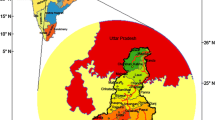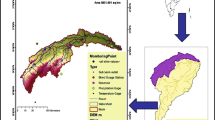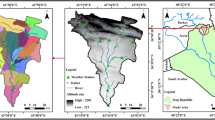Abstract
A semi-distributed, physically based, basin-scale Soil and Water Assessment Tool (SWAT) model was developed to determine the key factors that influence streamflow and sediment concentration in Purna river basin in India and to determine the potential impacts of future climate and land use changes on these factors. A SWAT domain with a Geographical Information System (GIS) was utilized for simulating and determining monthly streamflow and sediment concentration for the period 1980–2005 with a calibration period of 1980–1994 and validation period of 1995 to 2005. Additionally, a sequential uncertainty fitting (SUFI-2) method within SWAT-CUP was used for calibration and validation purpose. The overall performance of the SWAT model was assessed using the coefficient of determination (R2) and Nash–Sutcliffe efficiency parameter (ENS) for both calibration and validation. For the calibration period, the R2 and ENS values were determined to be 0.91 and 0.91, respectively. For the validation period, the R2 and ENS were determined to be 0.83 and 0.82, respectively. The model performed equally well with observed sediment data in the basin, with the R2 and ENS determined to be 0.80 and 0.75 for the calibration period and 0.75 and 0.65 for the validation, respectively. The projected precipitation and temperature show an increasing trend compared to the baseline condition. The study indicates that SWAT is capable of simulating long-term hydrological processes in the Purna river basin.










Similar content being viewed by others
References
Abbaspour KC, Vejdani M, Haghighat S, Yang J (2007) SWAT-CUP calibration and uncertainty programs for SWAT. In: MODSIM 2007 International Congress on Modelling and Simulation, Modelling and Simulation Society of Australia and New Zealand. pp 1596–1602
Abbaspour KC, Rouholahnejad E, Vaghefi S et al (2015) A continental-scale hydrology and water quality model for Europe: Calibration and uncertainty of a high-resolution large-scale SWAT model. J Hydrol 524:733–752. https://doi.org/10.1016/j.jhydrol.2015.03.027
Abbott MB, Bathurst JC, Cunge JA et al (1986) An introduction to the European Hydrological SystemSysteme Hydrologique Europeen, SHE, 1: History and philosophy of a physically-based, distributed modelling system. J Hydrol 87:45–59
Arnold JG, Moriasi DN, Gassman PW et al (2012a) SWAT: model use, calibration, and validation. Am Soc Agric Biol Eng 55:1491–1508
Arnold JG, Moriasi DN, Gassman PW et al (2012b) SWAT: Model use, calibration, and validation. Trans ASABE 55:1491–1508
Baker TJ, Miller SN (2013) Using the Soil and Water Assessment Tool (SWAT) to assess land use impact on water resources in an East African watershed. J Hydrol 486:100–111
Bergstrom S (2006) Experience from applications of the HBV hydrological model from the perspective of prediction in ungauged basins. IAHS Publ 307:97
Beven K (1997) TOPMODEL: A critique. Hydrol Process 11:1069–1085
Chaibou Begou J, Jomaa S, Benabdallah S et al (2016) Multi-Site Validation of the SWAT Model on the Bani Catchment: Model Performance and Predictive Uncertainty. Water 8:178
Chandra P, Patel PL, Porey PD, Gupta ID (2014) Estimation of sediment yield using SWAT model for Upper Tapi basin. ISH J Hydraul Eng 20:291–300
Cousino LK, Becker RH, Zmijewski KA (2015) Modeling the effects of climate change on water, sediment, and nutrient yields from the Maumee River watershed. J Hydrol Reg Stud 4:762–775
Daggupati P, Yen H, White MJ et al (2015) Impact of model development, calibration and validation decisions on hydrological simulations in West Lake Erie Basin. Hydrol Process 29:5307–5320
Das J, Umamahesh NV (2016) Downscaling monsoon rainfall over river Godavari Basin under different climate-change scenarios. Water Resour Manag 30:5575–5587
Debolini M, Schoorl JM, Temme A et al (2015) Changes in agricultural land use affecting future soil redistribution patterns: a case study in southern Tuscany (Italy). L Degrad Dev 26:574–586
Ficklin DL, Barnhart BL (2014) SWAT hydrologic model parameter uncertainty and its implications for hydroclimatic projections in snowmelt-dependent watersheds. J Hydrol 519:2081–2090
Gupta PK, Punalekar S, Panigrahy S et al (2011) Runoff modeling in an agro-forested watershed using remote sensing and GIS. J Hydrol Eng 17:1255–1267
Johnson MS, Coon WF, Mehta VK et al (2003) Application of two hydrologic models with different runoff mechanisms to a hillslope dominated watershed in the northeastern US: a comparison of HSPF and SMR. J Hydrol 284:57–76. https://doi.org/10.1016/j.jhydrol.2003.07.005
Khoi DN, Thom VT (2015) Parameter uncertainty analysis for simulating streamflow in a river catchment of Vietnam. Glob Ecol Conserv 4:538–548
Kumar N, Singh SK, Srivastava PK, Narsimlu B (2017) SWAT Model calibration and uncertainty analysis for streamflow prediction of the Tons River Basin, India, using Sequential Uncertainty Fitting (SUFI-2) algorithm. Model Earth Syst Environ 3:30
Lenderink G, Buishand A, Deursen W van (2007) Estimates of future discharges of the river Rhine using two scenario methodologies: direct versus delta approach. Hydrol Earth Syst Sci 11:1145–1159
Li T, Gao Y (2015) Runoff and sediment yield variations in response to precipitation changes: A case study of Xichuan Watershed in the Loess Plateau, China. Water 7:5638–5656. https://doi.org/10.3390/w7105638
Narasimhan B, Allen PM, Coffman SV et al (2017) Development and testing of a physically based model of streambank erosion for coupling with a Basin-Scale Hydrologic Model SWAT. J Am Water Resour Assoc 53:344–364
Nilawar AP, Calderella CP, Lakhankar TY et al (2017) Satellite soil moisture validation using hydrological SWAT model: a case study of Puerto Rico. USA Hydrol 4:45
Paul M, Negahban-Azar M (2018) Sensitivity and uncertainty analysis for streamflow prediction using multiple optimization algorithms and objective functions: San Joaquin Watershed, California. Model Earth Syst Environ 1–17
Pazúr R, Bolliger J (2017) Land changes in Slovakia: past processes and future directions. Appl Geogr 85:163–175
Sarangi A, Cox CA, Madramootoo CA (2007) Evaluation of the AnnAGNPS Model for prediction of runoff and sediment yields in St Lucia watersheds. 97:241–256. https://doi.org/10.1016/j.biosystemseng.2007.02.015
Seibert J, Vis MJP (2012) Teaching hydrological modeling with a user-friendly catchment-runoff-model software package. Hydrol Earth Syst Sci 16:3315–3325. https://doi.org/10.5194/hess-16-3315-2012
Setegn SG, Srinivasan R, Dargahi B (2008) Hydrological modelling in the Lake Tana Basin, Ethiopia Using SWAT Model. Open Hydrol J 2:49–62. https://doi.org/10.2174/1874378100802010049
Shi P, Hou Y, Xie Y et al (2013) Application of a SWAT model for hydrological modeling in the Xixian Watershed, China. J Hydrol Eng 18:1522–1529
Srinivasan R, Zhang X, Arnold J (2010) SWAT ungaged: Hydrological budget and crop yield predictions in the Upper Mississipp River basin. Trans Am Soc Agric Biol Eng 53:1533–1546. https://doi.org/10.13031/2013.34903
Sun J, Li YP, Huang GH, Wang CX (2017) Analysis of interactive effects of DEM resolution and basin subdivision level on runoff simulation in Kaidu River Basin, China. Hydrol Res 48:1100–1117
Tang FF, Xu HS, Xu ZX (2012) Procedia Environmental Model calibration and uncertainty analysis for runoff in the Chao River Basin using sequential uncertainty fitting. https://doi.org/10.1016/j.proenv.2012.01.170
Teutschbein C, Seibert J (2012) Bias correction of regional climate model simulations for hydrological climate-change impact studies: review and evaluation of different methods. J Hydrol 456:12–29
Wangpimool W, Pongput K, Supriyasilp T, Sakolnakhon KPN (2013) 1-p-Hydrological evaluation with SWAT model and numerical weather prediction for flash flood warning system in Thailand. 6:349–357
Williams JR, Kannan N, Wang X et al (2011) Evolution of the SCS runoff curve number method and its application to continuous runoff simulation. J Hydrol Eng 17:1221–1229
Worku T, Khare D, Tripathi SK (2017) Modeling runoff–sediment response to land use/land cover changes using integrated GIS and SWAT model in the Beressa watershed. Environ Earth Sci 76:550
Xue C, Chen B, Wu H (2013) Parameter uncertainty analysis of surface flow and sediment yield in the Huolin Basin, China. J Hydrol Eng 19:1224–1236
Yang L, Feng Q, Yin Z et al (2017) Identifying separate impacts of climate and land use/cover change on hydrological processes in upper stream of Heihe River, Northwest China. Hydrol Process 31:1100–1112
Acknowledgements
The authors are thankful to TEQIP, DST-FIST, CoE and authorities of SGGS IE &T for providing a work-station and for giving valuable guidance for completing the study.
Author information
Authors and Affiliations
Corresponding author
Additional information
Publisher’s Note
Springer Nature remains neutral with regard to jurisdictional claims in published maps and institutional affiliations.
Rights and permissions
About this article
Cite this article
Nilawar, A.P., Waikar, M.L. Use of SWAT to determine the effects of climate and land use changes on streamflow and sediment concentration in the Purna River basin, India. Environ Earth Sci 77, 783 (2018). https://doi.org/10.1007/s12665-018-7975-4
Received:
Accepted:
Published:
DOI: https://doi.org/10.1007/s12665-018-7975-4




